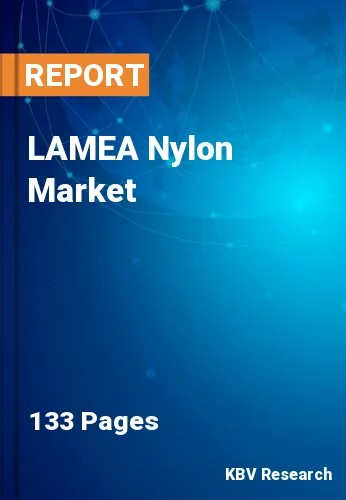The Latin America, Middle East and Africa Nylon Market would witness market growth of 7.6% CAGR during the forecast period (2023-2030). In the year 2026, the LAMEA market's volume is expected to surge to 1,467.4 Kilo Tonnes, showcasing a growth of 7.4% (2023-2030).
The electronics industry relies heavily on nylon for its insulating properties and structural integrity. From circuit boards to cable insulation, these compounds provide crucial insulation against electrical currents and mechanical stress, ensuring the reliability and longevity of electronic devices in an increasingly interconnected world. Additionally, the polyamide industry is increasingly focusing on environmentally friendly production methods in response to heightened environmental consciousness. Companies invest in technologies to reduce energy consumption, minimize waste generation, and develop bio-based or recycled materials.
Sustainable sourcing and production processes are becoming integral to the value proposition of these products, catering to eco-conscious consumers and regulatory requirements. Moreover, recycling technologies have advanced significantly, enabling the production of high-quality recycled nylon from post-consumer or post-industrial waste streams. Recycling offers environmental benefits by diversifying waste from landfills and reducing the need for virgin materials. Manufacturers incorporate recycled form into their product portfolios, offering consumers sustainable alternatives without compromising performance or quality.
The rising electric vehicle industry in the UAE is expected to create opportunities for the market, particularly in automotive applications such as lightweight materials, battery enclosures, interior components and others. According to the International Trade Administration (ITA), the number of EVs in Dubai is estimated to be approximately 7,331 in 2023 and is expected to reach 12,852 by 2025. This aligns with Dubai’s Green Mobility Strategy 2030, stipulating that by 2030, 10% of all vehicle sales and 30% of public sector vehicles must be electric or hybrid. Dubai Roads and Transport Authority (RTA) also successfully converted 50% of the Dubai taxi fleet into hybrid vehicles. By 2027, the organization strives to convert its transport fleet to hybrid and electric vehicles fully. Hence, the expansion of the EV sector and growing expenditure in the construction sector is propelling the market’s growth.
The Brazil market dominated the LAMEA Nylon Market, By Country in 2022, and would continue to be a dominant market till 2030; thereby, achieving a market value of $1,523 million by 2030. The Argentina market is showcasing a CAGR of 8.7% during (2023 - 2030). Additionally, The UAE market would register a CAGR of 7.3% during (2023 - 2030).
Free Valuable Insights: The Worldwide Nylon Market is Projected to reach USD 50.2 Billion by 2030, at a CAGR of 6.1%
Based on Material, the market is segmented into Nylon 6, and Nylon 66. Based on Application, the market is segmented into Automobile, Electrical & Electronics, Engineering Plastics, Textile, and Others. Based on countries, the market is segmented into Brazil, Argentina, UAE, Saudi Arabia, South Africa, Nigeria, and Rest of LAMEA.
By Material (Volume, kilo Tonnes, USD Billion, 2019-2030)
By Application (Volume, kilo Tonnes, USD Billion, 2019-2030)
By Country (Volume, kilo Tonnes, USD Billion, 2019-2030)
Our team of dedicated experts can provide you with attractive expansion opportunities for your business.

